Ata-ul-Haye Nasir, Ahmadiyya Archive & Research Centre
In 1908, when the Promised Messiahas passed away, the opponents of Ahmadiyyat assumed it to be the end of his mission. They seemed to be celebrating a hollow “victory” and made bold claims about the end of Ahmadiyyat. Moreover, in various instances in the following years too, they continued to make such predictions.
The Nur Afshan of Ludhiana was leading the Christian rhetoric against Islam. This paper left no stone unturned in opposing the Promised Messiahas and published inflammatory articles. Among the Muslim press, The Paisa Akhbar of Lahore and the Ahl-i-Hadith of Amritsar were at the forefront in opposing him. In 1914 too, amidst the internal conflict1 on the issue of Khilafat, these newspapers made bold predictions about the end of Ahmadiyyat.
1908: The birth of Khilafat-e-Ahmadiyya
As per the promise of Allah the Almighty, Khilafat-e-Ahmadiyya was established in 1908. A Lahore-based English newspaper reported:
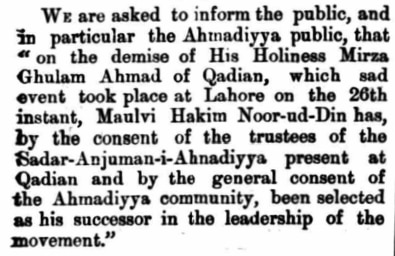
“Maulvi Hakim Noor-ud-Din[ra] has, by the consent of the trustees of the Sadar-Anjuman-i-Ahmadiyya present at Qadian and by the general consent of the Ahmadiyya community, been selected as his successor in the leadership of the movement.”2
As indicated above, The Nur Afshan (English) asserted that with Hazrat Ahmad’sas demise, his mission would soon cease to exist. It wrote that his “followers under the leadership of Maulvi Nur-ud-Din[ra], like the Doweyites, may strive to perpetuate the religion of their dead prophet but the probability is that it will soon become a memory.”3
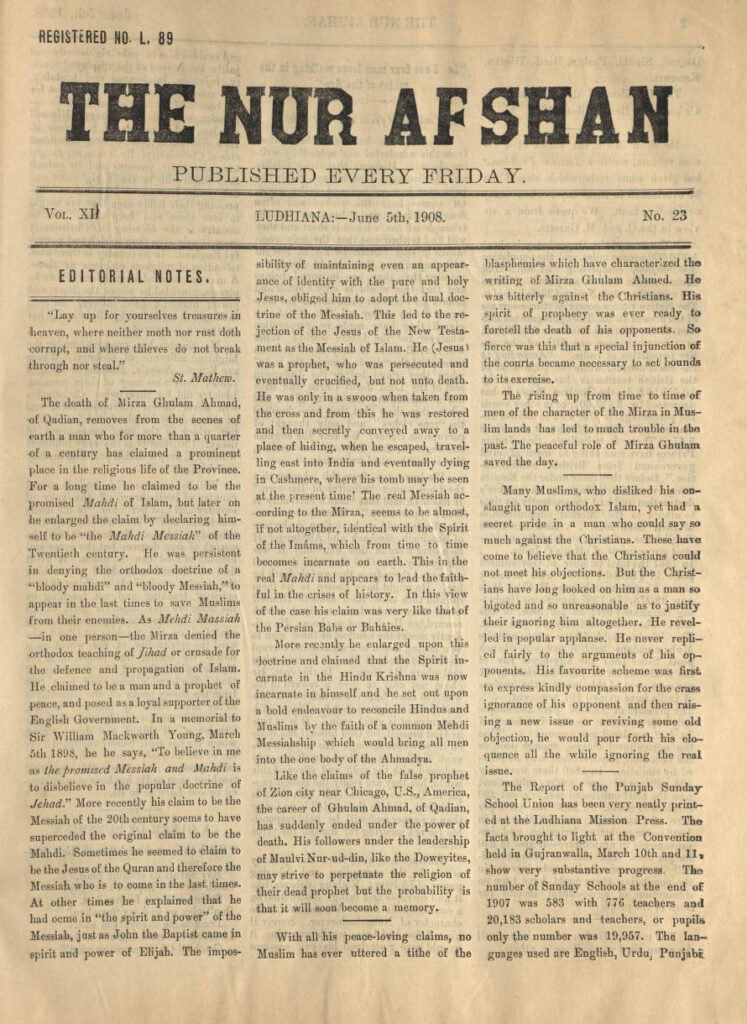
However, during the blessed era of Hazrat Khalifatul Masih Ira, the Promised Messiah’sas mission continued to leap forward with great success. Then came March 1914, and at that time, not only did the opponents of Ahmadiyyat see it as their “victory”, even a section of the Jamaat, which was silently brewing its anti-Khilafat rhetoric during the past six years, openly came forward and announced their propaganda against the need for Khilafat.
1914: The opponents’ predictions and ambitions
Amidst the above-mentioned conflict regarding Khilafat, the Muslim press of British India published inflammatory articles, predicting the destruction of Ahmadiyyat.
Maulvi Sanaullah of Amritsar – a staunch opponent of the Promised Messiahas – ran a newspaper called Ahl-i-Hadith, which had a history of publishing anti-Ahmadiyya articles. In 1914, he published a booklet titled Guldasta-e-Sana‘ie, which was a compilation of his articles. In March 1914, he mentioned the demise of Hazrat Khalifatul Masih Ira and wrote:
“What will be the fate of the Qadiani Mission after him? Only God knows about it. However, we learn from the signs that there will be huge disagreement, and it will result in:
تین تیرہ ہونے والی ہے جماعت آجکل ؏
“[i.e., the Jamaat will soon be scattered or destroyed]. Though we feel immense regret about this, we cannot resist ourselves from expressing the truth.” He further expressed that despite the religious differences, “we value their courage and passion.”4
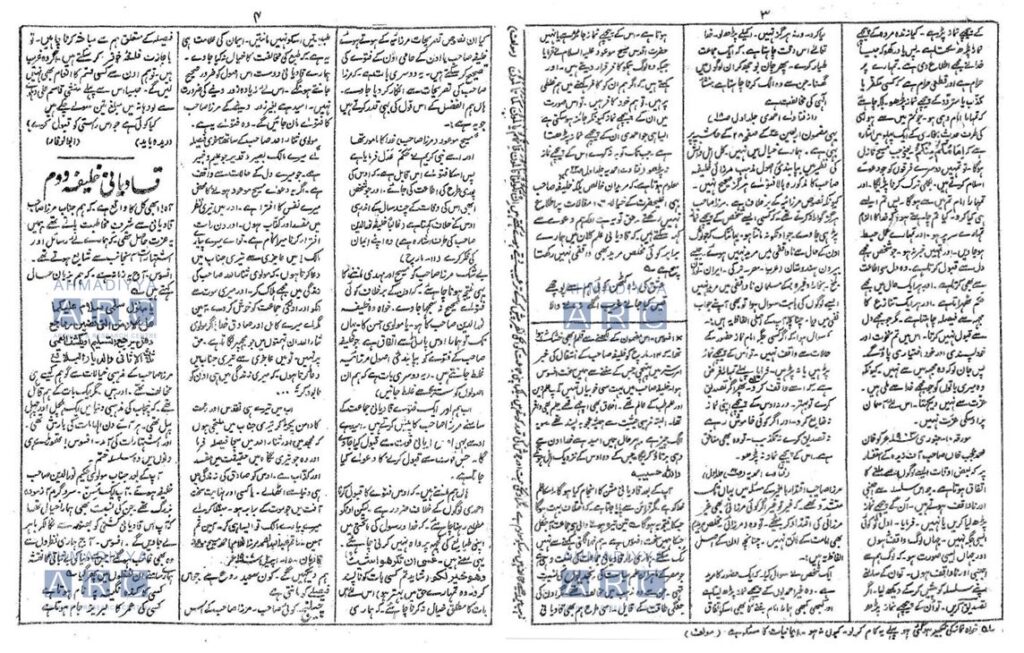
Commenting on the events following the demise of Hazrat Khalifatul Masih Ira, Maulvi Sanaullah wrote:
“Many people pledged allegiance to Mian Mahmud, son of Mirza Sahib Qadiani and some leaders refrained from it. The opposing group published their views through a statement which suggests that they do not agree with Khilafat of an individual; rather, they assume that ‘for our administration, our Anjuman is sufficient.’ If anyone asks us about our view, we are of the opinion that their view is incorrect; an imam and leader is always required.”5
Another prominent Muslim newspaper, The Paisa Akhbar of Lahore, published a short article and spread the rumours that Khwaja Kamal-ud-Din Sahib had been requested to return to India to settle the issue regarding Khilafat:
“A rumour is current in Lahore that a telegram has been sent to Khwaja Kamaluddin Sahib in London on 14 March, informing him of the demise of Maulvi Noor-ud-Deen Sahib and that there is a dispute concerning the Ahmadi Khilafat, hence, ‘You ought to return.’ If Khawaja Sahib consents as well, it is not unlikely that he will return and a section of Ahmadi Jamaat will make him the Khalifa, since he also holds right within his Jamaat.”6
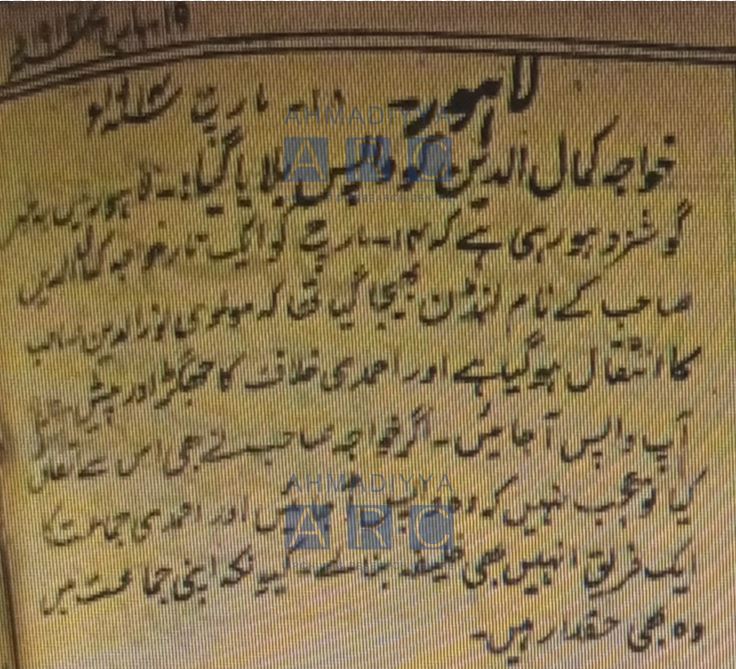
Mentioning this article by The Paisa Akhbar and its rebuttal by the Akhbar Zamindar, the Indian Newspaper Reports states under the heading “Khwaja Kamal-ud-din and Ahmadis”:
“In a note entitled ‘Rumour of the recall of Khawaja Kamal-ud-din,’ the Zamindar (Lahore), of the 25th March 1914, says that […] the Secretary of the Central Ahmadi Association, Kadian, announces that no such message has been sent to Khawaja Kamal-ud-din. There can be no denying the fact, it adds, that owing to the death of Maulvi Nur-ud-din there has occurred a temporary split among the Ahmadis, but they have acted wisely in not sending for Khawaja Kamal-ud-din.”7
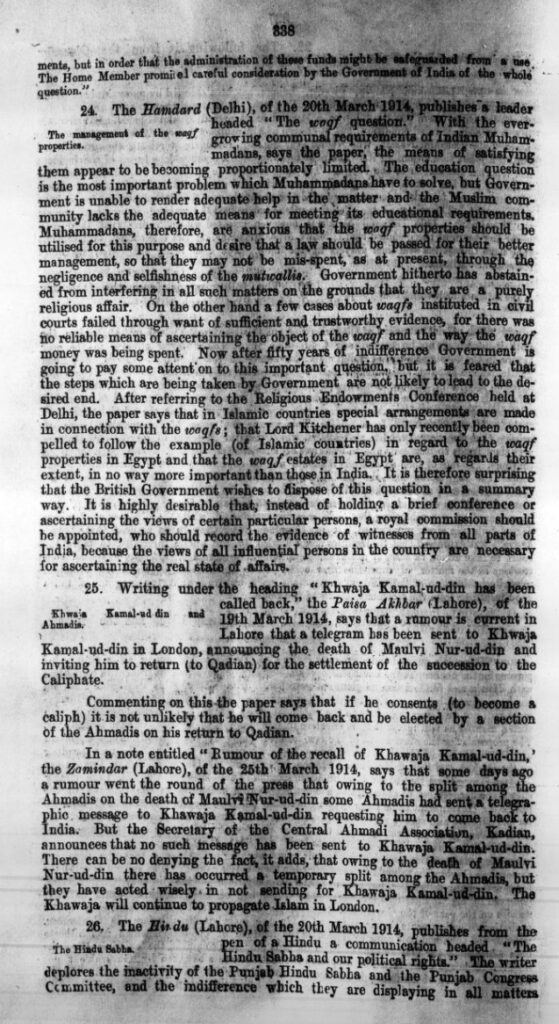
The Times of India, another prominent Indian newspaper, also reported on this subject. Furthermore, the Nur-i-Afshan of Ludhiana commented in the following words:
“It has been announced from Qadian that Maulvi Noor-ud-Deen Sahib who was the Khalifa and successor of Mirza Ghulam Ahmad Qadiani, has passed away on 13 March 1914 after the Jumuah prayer. Moreover, after him, on 14 March 1914, at the Noor Mosque in Qadian, Mirza Bashir-ud-Din Mahmud Ahmad Sahib – the son of the late Mirza Ghulam Ahmad Sahib Qadiani – has been elected as the Khalifa. We sympathise from our heart with the survivors of the late Maulvi Sahib. May God grant them patience.”8
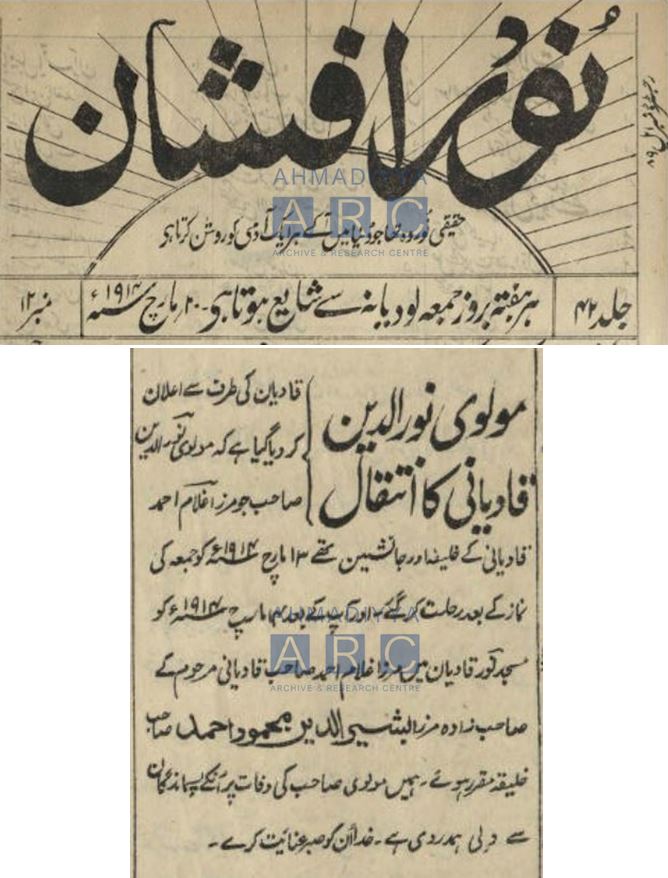
On the one hand, the opponents of Khilafat were leaving no stone unturned in spreading internal chaos and disorder; on the other, the opponents of Islam Ahmadiyyat considered it to be their “victory” and presumed that the Jamaat would soon be effaced from the face of the earth. However, the support and help of God remained with Khilafat-e-Ahmadiyya, as witnessed by the world in the times to follow.
As for the hollow and temporary “victory” of the opponents of Ahmadiyyat, we find that The Paisa Akhbar of Lahore was making fun of the situation and published some articles that aimed at mocking Jamaat-e-Ahmadiyya. For instance, its 19 March 1914 issue published a short article titled “Jamaat-e-Ahmadiyya ke teen firqay” – Three sects of Jamaat-e-Ahmadiyya.
We also learn that the intelligence reports of the Government regularly mentioned these events. A report by the Director of Criminal Intelligence, dated 31 March 1914, mentioned the split on the issue of Khilafat. In the next report, dated 7 April 1914, he mentioned the election of Khalifatul Masih II, and stated:
“Qadian.–The leadership of the Ahmadi sect.–In my last report I mentioned that dissension had arisen among the Ahmadis over the leadership of the sect on the death of Hakim Nur-ud-din. Since then Mahmud Sahibzada, son of the founder of the sect, has been elected Khalifa. His election however has not put an end to the dissensions.”9
In general, the report seemed to be very much influenced by the false notions propagated by the opponents of Khilafat.
The Ahl-i-Hadith of 10 April 1914 published an article, titled “Qadiani Mission mein Ikhtilaf” (lit., “Disagreement within the Qadiani Mission”) in which Maulvi Sanaullah of Amritsar wrote that Ahmadis would claim that they are the only Ahl-i-Sunnat wal-Jamaat since they have an Imam, but now an internal disagreement has occurred on the issue of the Imam.
The article further mentioned that Hazrat Mirza Bashir-ud-Din Mahmud Ahmadra was elected as the Khalifatul Masih II, but the “educated” party opposed this and denied the need for any Khalifa, but rather said that the Sadr Anjuman was sufficient to run the Jamaat. The editor further wrote that in his view, an Amir is essential for a Jamaat and “after the demise of Mirza Sahib, despite the existence of Sadr Anjuman Ahmadiyya, Maulvi Noor-ud-Deen’s election took place on the same principle.”10
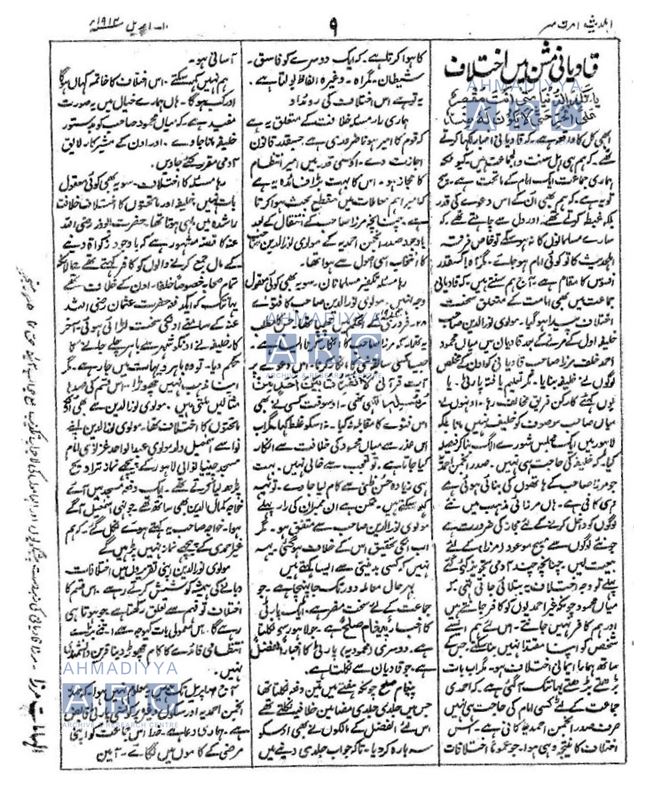
Another report by the Director of Criminal Intelligence, dated 21 April 1914, mentioned two meetings held by the ghair-mubai‘een towards the end of March, and wrote, “A division in the Ahmadi sect.–The party opposed to the election of the Sahibzada Bashir-ud-din Mahmud to the leadership of the Ahmadi sect held a meeting at Lahore on the 22nd March.”
It further stated that the “second meeting, attended by about 20 persons, was held at Lahore on the 28th March. It was resolved to form a separate society called the Anjuman-i-Ishaat-ul-Islam (Society for the propagation of Islam) with headquarters at Lahore. Muhammad Ali, editor of The Review of Religions, the leader of the party, opposed to the Sahibzada, was requested to live at Lahore and publish his paper there.”11
In a later report, dated 19 May 1914, the Director wrote, “The Ahmedi Sect.–Dissensions among the Ahmedi Sect are still acute. It is expected that Khwaja Kamal-ud-din, who is at present preaching Islam in London, will shortly return to India, with the object of affecting a settlement.”12
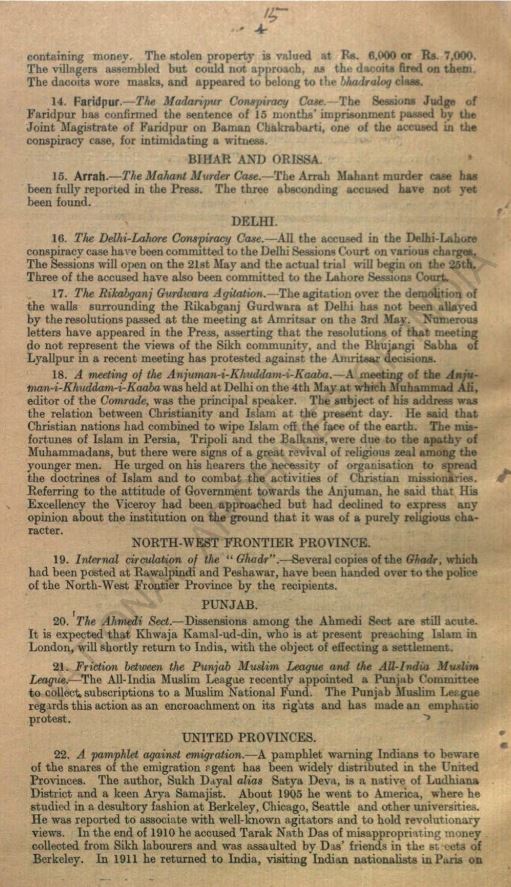
Coming back to the newspapers, The Paisa Akhbar of 24 May 1914 published another article under the heading “Mirzai Jamaat ki tabaahi ke aasaar”. The Indian Newspaper Reports mentioned this article and wrote under the heading “The Ahmadis”:
“Writing under the heading ‘The signs of destruction of the followers of the Mirza’, the Paisa Akhbar (Lahore), of the 24 May 1914, says that now that Maulvi Nur-ud-Din is dead, the followers of Mirza have grouped themselves into two parties, one of which acknowledges Mirza Mahmud Ahmad, the son of the late Mirza Ghulam Ahmad of Kadian, as its Amir, Imam and Prophet, while the other acknowledges Maulvi Muhammad Ali, M.A., as the Amir and Imam of the Ahmadi sect. Both the aforesaid caliphs, it adds, are carrying on their work vigorously. The paper remarks that Maulvi Muhammad Ali, M.A., the majority of whose followers consists of educated persons, is willing to cooperate with Muhammadans and does not call any reciter of the Kalima an infidel, and that his views are the same as that of Khwaja Kamal-ud-Din. It remains to be seen, therefore, which of the two parties under reference gains the supremacy and overpowers the other.”13
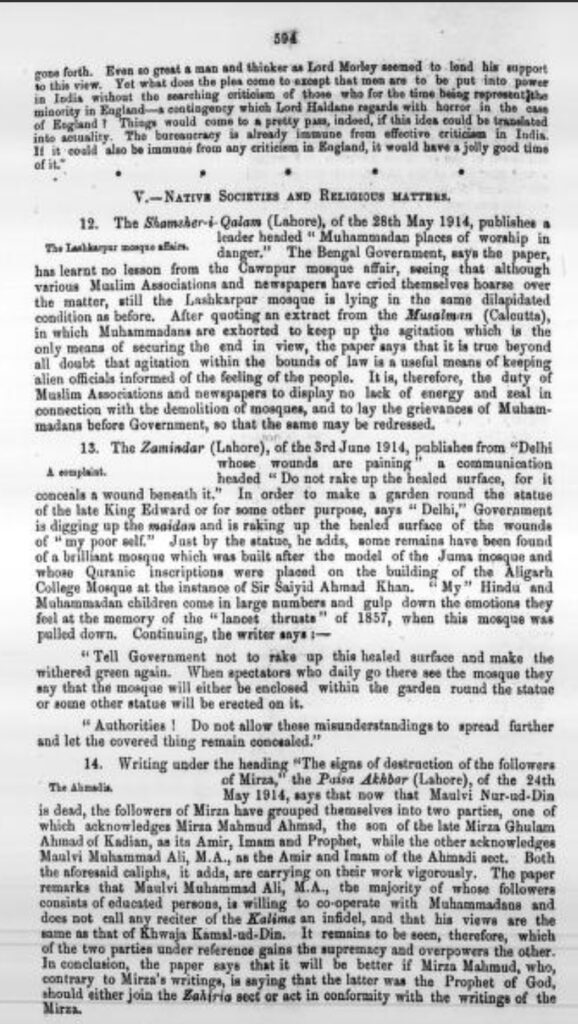
Here, The Paisa Akhbar posed a very pertinent point that it was yet to be seen which of the two parties gained the supremacy and overpowered the other.
Is it difficult to decide as to which party stood supreme? Not at all. 111 years have passed since this incident and it is a proven fact that the Ahmadiyya Muslim Jamaat has achieved immense progress under the blessed leadership of Khilafat-e-Ahmadiyya and continues to leap forward with each passing day, alhamdulillah, and will continue to do so, insha-Allah.
Looking at further issues of Ahl-i-Hadith, we find that the editor started to side with the opponents of Khilafat and particularly commended the works of Khawaja Kamaluddin Sahib and criticised those who pledged allegiance to Hazrat Khalifatul Masih IIra. For instance, in the 12 June 1914 issue, the editor commended Khawaja Sahib and criticised the articles which were published recently in Al Hakam and Al Haqq. In the 19 June issue, he asserted that according to the Quran and Hadith, the Lahori group was on the truth and the Qadiani group was true according to the principles laid by Mirza Sahib. In this way, he attempted to imply that the Promised Messiah’sas teachings were against the Holy Quran and Hadith, God forbid.
In its 15 May and 5 June 1914 issues, the same newspaper used inappropriate language against Hazrat Khalifatul Masih IIra and asserted that the prominent members of the Jamaat had not yet accepted him as the Khalifa. The editor further mentioned that the members of the Jamaat were giving him various titles, such as Ulul-Azm, Fazl-e-Umar and the Promised Son, and declared him the recipient of various revelations of the Promised Messiahas.
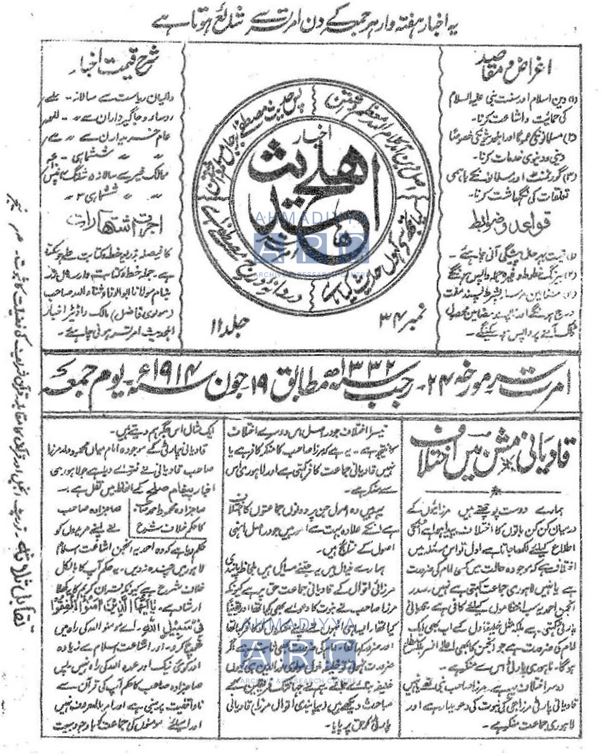
This series of articles continued in the coming months as well, and in general, the statements in these articles suggested that the editor saw this internal disagreement as his victory and the end of the Promised Messiah’sas mission.
1914: Khilafat and Al Hakam
In an editorial of Al Hakam, dated 14 August 1918, Hazrat Sheikh Yaqub Ali Irfanira wrote about the events of 1914 and stated:
“At that juncture, the continuation of Al Hakam was crucial. In the midst of the disorder that arose at the demise of Hazrat Khalifatul Masih Ira, Al Hakam, by the grace of God, was at the forefront in the capacity of a successful and experienced soldier. However, various ignorant and shortsighted people assumed that Al Hakam was responsible for this happening; hence, the Divine decree postponed its publication, to let it be clear that it is solely the Hand of God that acts in support of Khilafat. Around two years later, Al Hakam was reinstated once again and this is now its new era.
“It is the collective responsibility of every sincere Ahmadi to preserve this memorial of the blessed era of the Promised Messiahas. This is the newspaper that the Promised Messiahas declared to be his ‘arm’. This is the newspaper that succeeded as a great sign in all that the Promised Messiahas presented. Thereafter, Hazrat Khalifatul Masih Ira made an appeal in relation to its establishment and sustenance. In the final days of his life, he entrusted its responsibility to his successor, Hazrat Khalifatul Masih II[ra].”14
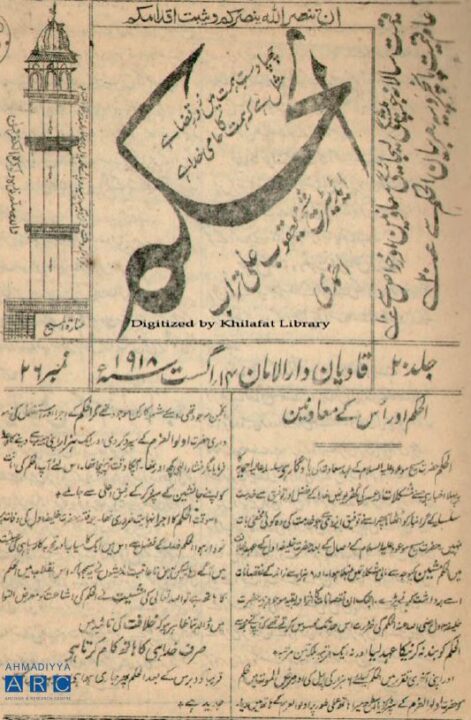
Khilafat: Continuously turning fear into peace
In 1908 and 1914, not only the Christians but even the Muslim clerics predicted the end of the Promised Messiah’sas mission and celebrated their hollow “victories”. However, today, the progeny and followers of those opponents are witness to the fact that his mission is continuing to flourish under the banner of Khilafat-e-Ahmadiyya, and will continue to do so, insha-Allah.
During the past 117 years of Khilafat-e-Ahmadiyya, we have witnessed its glory and blessings. Whenever there has been a state of fear, due to the endeavours of the opponents of Ahmadiyyat or any conspiracy against this blessed institution, Khilafat-e-Ahmadiyya has stood victorious and has always turned that fear into peace.
We are currently living in the blessed era of Hazrat Khalifatul Masih Vaa and reaping the fruits of its blessings, and those who rejected the need for Khilafat in the past, or indulge in conspiracies against the blessed institution of Khilafat, have become insignificant. May Allah the Almighty enable us all to become His true servants by holding fast to the “rope” that He has granted us, i.e., the blessed institution of Khilafat-e-Ahmadiyya. Amin.
اَللّٰھُمَّ اَیِّدْ اِمَامَنَا بِرُوْحِ الْقُدُسِ وَ بَارِکْ لَنَا فِیْ عُمُرِہٖ وَ اَمْرِہٖ
Endnotes
1. “The fate of those who rejected Khilafat”, alhakam.org, 22 May 2020
2. The Civil and Military Gazette, 30 May 1908
3. The Nur Afshan, 5 June 1908, Vol. 12, No. 23, p. 1
4. Guldasta-e-Sana‘ie, Vol. 4, p. 3
5. Ibid., p. 5
6. The Paisa Akhbar, 19 March 1914, p. 8
7. Indian Newspaper Reports, c1868-1942, Part 8, Vol. 27, No. 13, p. 338
8. Nur-i-Afshan, 20 March 1914
9. National Archives of India, Government of India: Home Department, File: Proceedings, May 1914, Nos. 137-140
10. Ahl-i-Hadith, 10 April 1914, p. 9
11. National Archives of India, Government of India: Home Department, File: Proceedings, May 1914, Nos. 137-140
12. Ibid.
13. Indian Newspaper Reports, c1868-1942, Part 8, Vol. 27, No. 23, p. 594
14. “Al Hakam: A glimpse into its history and relaunch during the blessed era of Khilafat-e-Khamisa”, alhakam.org, 24 March 2023

